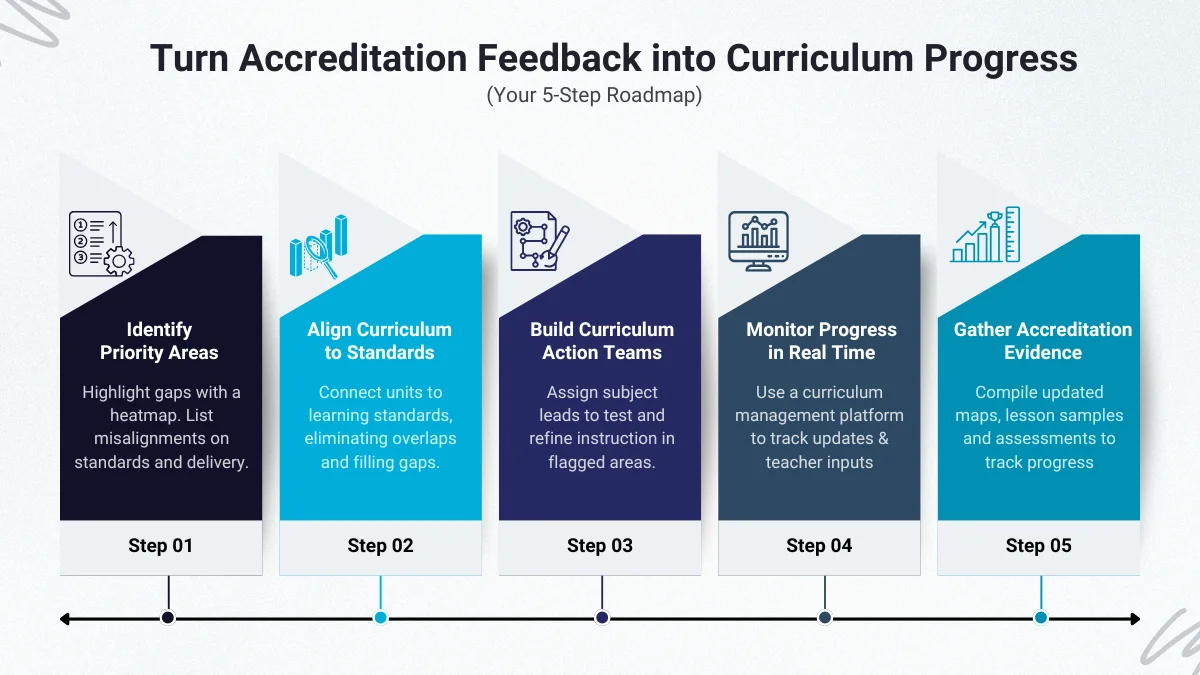Schedule a free demo to learn more
From Accreditation Feedback to Action: A Curriculum Mapping Roadmap for School Leaders
1st July 2025

Accreditation feedback doesn’t just highlight areas of improvement, it offers a strategic opportunity to strengthen your school’s instructional foundation. But here’s the challenge- while most schools recognize the value of these insights, far fewer have a clear, structured approach to act on them. Feedback gets buried in static reports. Curriculum changes remain fragmented. And momentum fades after the accreditation visit ends.
Now, imagine a different outcome where your team turns every recommendation into a clear curriculum action plan. Where standards, instruction and assessments are aligned and transparent; where your next accreditation review is backed by evidence of real progress.
In today’s blog, we’ll show you how to make that a reality using curriculum mapping and management as your strategic engine. Backed by recent data and built for the realities of 2025, this roadmap is designed to help school leaders like you turn feedback into long-term academic success.
Why does Accreditation Feedback often fall short without Curriculum Mapping?
For many schools, accreditation reviews surface important issues but acting on them is another matter. A 2025 survey by Frontline Education found that while 78% of administrators valued their feedback, only 52% felt equipped to follow through on recommendations. So what are the most common barriers?
- Too many priorities, not enough clarity
- Static documents that lack accountability
- Disjointed systems for instruction and standards tracking
- Little to no ongoing curriculum management framework
Without a dynamic curriculum mapping process in place, accreditation feedback often stays theoretical, rather than becoming a driver of real, measurable progress.
Curriculum Mapping Gaps that Accreditors Keep Flagging
Across hundreds of accreditation reports, certain curriculum-related issues appear time and again:
Standards misalignment and redundancies
Curriculum maps often reveal where key standards are either missing or duplicated across grade levels. A 2024 EdReports audit found that nearly one-third of U.S. schools experienced unintentional instructional overlap in core subjects.
Lack of horizontal and vertical coherence
Without clear mapping, it’s difficult to ensure that students build knowledge from year to year. Misaligned scope and sequence can lead to gaps in learning that directly impact student performance.
Outdated or inconsistent curriculum documentation
Accrediting bodies like Cognia, WASC and ACSI now expect schools to demonstrate active, ongoing curriculum management instead of static plans only submitted every few years.
Limited Teacher Engagement
Curriculum updates and mapping processes often lack transparency or shared ownership, resulting in inconsistent implementation across departments.
These issues not only hinder student learning but also make it more difficult to provide the kind of comprehensive evidence accreditors are now looking for.
Using Curriculum Mapping to Drive Accreditation-ready Change: A 5-step Roadmap
Here’s how school leaders can take a strategic, data-informed approach to curriculum improvements:

Step 1: Visualize Priorities with a Curriculum Mapping Heatmap
Start by translating your accreditation feedback into a visual dashboard or heatmap. Categorize issues as high, medium or low priority. Use color coding to highlight standards misalignment, instructional redundancies or underdeveloped assessment strategies.
This clarity allows leadership teams to focus energy and resources where they will have the greatest impact.
Step 2: Map the Curriculum Against Standards
Once the priority areas are defined, conduct a full curriculum mapping exercise:
- Align each course or grade level to relevant standards
- Link units to instructional goals and assessments
- Identify content gaps, overlaps or inconsistencies
Implementing this process can bring about a significant reduction in instructional redundancy and improve reading and mathematical proficiency among students.
Step 3: Assign Curriculum Action Teams
For each red zone identified, assign a dedicated action team, typically a department lead and 2 to 3 teachers. Empower them to:
- Propose curriculum revisions
- Test and pilot changes
- Gather artifacts such as lesson plans, student work and assessment results
When teachers are engaged as co-creators, implementation fidelity increases substantially.
Step 4: Track Fidelity with Real-time Curriculum Management tools
Use a curriculum management platform like Edusfere to monitor:
- Standards coverage by grade, subject and unit
- Teacher engagement with the map
- Progress on curriculum updates
According to a RAND study in 2024, schools using real-time dashboards and data tracking tools saw a 23% improvement in alignment fidelity and 30% faster implementation cycles.
Step 5: Review, Refine & Prepare Evidence
Finally, close the loop with a structured review process:
- Assess changes against student outcomes
- Update the heatmap and curriculum map accordingly
- Compile documentation and artifacts for future accreditation
This process ensures feedback turns into continuous improvement and not just a reactive checklist.
Success Story Snapshot: Curriculum Mapping in Action
Let’s take a look at how one district translated accreditation feedback into tangible instructional gains.
Following a Cognia review, Moscow School District in Idaho undertook a district-wide curriculum alignment initiative. The goal was to connect instruction more closely to standards, improve vertical alignment across grades and enhance student performance in core academic areas.
With collaboration across teams and a renewed focus on standards-based curriculum management, the district:
- Created a clear, unified instructional framework
- Engaged staff in collaborative curriculum mapping sessions
- Aligned science curriculum to address identified gaps in instructional rigor
As a result, high school science performance improved significantly with students achieving an increase from 39% to 46% at the advanced level, according to Cognia.
This example demonstrates how structured curriculum mapping and data-backed action planning can directly support accreditation readiness and long-term student success.
Why Edusfere is built for Accreditation-driven Curriculum Mapping
Edusfere provides an integrated platform that empowers school leaders to act on accreditation feedback with confidence:
- Live Curriculum Mapping: Map standards, lessons and assessments in real time across teams.
- Interactive Dashboards: Monitor curriculum health, teacher participation and implementation progress.
- Evidence Portfolio Builder: Seamlessly collect lesson plans, unit overviews and student work for accreditation reporting.
- National Standards Alignment: Support for Cognia, WASC and ACSI curriculum.
With Edusfere, curriculum is no longer just compliant, it becomes a living, evolving tool for school-wide improvement.
How School Leaders can implement a robust process
Accreditation success isn’t just about preparing for the review, it’s about building systems that support continuous improvement long after the evaluation is over. For school leaders, the next step lies in creating a sustainable infrastructure for curriculum mapping and curriculum management that’s not only compliant but transformational.
If your school has recently undergone an accreditation review or is preparing for one, this is the perfect moment to build momentum. Use this opportunity to engage staff in collaborative planning, streamline curriculum data and foster a culture of shared accountability.
To lead with clarity and purpose, consider the following steps:
- Set aside dedicated planning time each term for curriculum mapping and review
- Appoint department-level curriculum leads to champion the process
- Provide regular professional development on curriculum mapping and data analysis
- Use dashboards to highlight and celebrate curriculum wins with your team
Make Accreditation a Springboard for Academic Growth
When you align accreditation feedback, curriculum mapping and curriculum management, your school becomes more than compliant. It becomes future-ready.
Book a demo with Edusfere to see how our platform can help your school turn feedback into focused action and focused action into student success. Let’s move from static reports to living progress, together.